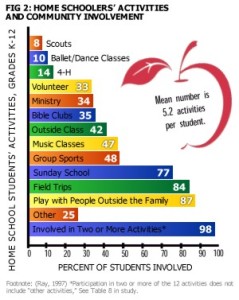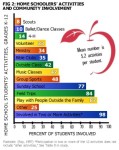by Will Estrada and Katie Tipton – HSLDA:
The U.S. Department of Education is prohibited by law from creating a national data system. But the Education Science Reform Act of 2002 gave the federal government the authority to publish guidelines for states developing state longitudinal data systems (SLDS). Over the past decade, a slew of new federal incentives and federally funded data models have spurred states to monitor students’ early years, performance in college, and success in the workforce by following “individuals systematically and efficiently across state lines.” We believe that this expansion of state databases is laying the foundation for a national database filled with personal student data.
Home School Legal Defense Association has long opposed the creation of such a database. We believe that it would threaten the privacy of students, be susceptible to abuse by government officials or business interests, and jeopardize student safety. We believe that detailed data systems are not necessary to educate young people. Education should not be an Orwellian attempt to track students from preschool through assimilation into the workforce.
At this point, it does not appear that the data of students who are educated in homeschools or private schools are being included in these databases. But HSLDA is concerned that it will become increasingly difficult to protect the personal information of homeschool and private school students as these databases grow. Oklahoma’s P20 Council has already called for databases to include the personal data of homeschool students.
The Development of a National Database
The Department of Education laid the foundation for a nationally linkable, comprehensive database in January 2012 when it promulgated regulations altering the Family Educational Rights and Privacy Act (FERPA). FERPA formerly guaranteed that parents could access their children’s personally identifiable information collected by schools, but schools were barred from sharing this information with third parties. Personally identifiable information is defined by FERPA as information “that would allow a reasonable person in the school community, who does not have personal knowledge of the relevant circumstances, to identify the student with reasonable certainty,” including names of family members, living address, Social Security number, date and place of birth, disciplinary record, and biometric record. However, the Department of Education has reshaped FERPA through regulations so that any government or private entity that the department says is evaluating an education program has access to students’ personally identifiable information. Postsecondary institutes and workforce education programs can also be given this data. This regulatory change absent congressional legislation has resulted in a lawsuit against the Department of Education, though a judge in the U.S. District Court for D.C. dismissed the suit on an issue of standing.
Guidelines for building SLDS that can collect and link personally identifiable information across state lines have been released by task forces funded by both the Department of Education and special interests groups. Many of these recommendations were compiled in the National Education Data Model (NEDM) v. 3.0, a project funded by Department of Education and overseen by the Council for Chief State School Officers (CCSSO), one of the organizations that created the Common Core. According to the NEDM website, 18 states and numerous local educational agencies are using this model for their state longitudinal databases. In addition, numerous states are still following other database models such as the Data Quality Campaign’s 10 Essential Elements, the State Core Data Set, the Common Education Data Standards, and the Schools Interoperability Framework, an initiative that received $6 million of federal funding in Massachusetts alone. Concentrating data collection around a few models means that states are getting closer and closer to keeping the same data and using the same interoperable technology to store it. Forty-six states currently have databases that can track students from preschool through the workforce (P-20W).
Driving the Data Collection
In addition to funding data models, the federal government has driven a national database through legislation. The 2009 federal stimulus bill created the State Fiscal Stabilization Fund as “a new one-time appropriation of $53.6 billion.” With this money, the Department of Education gave money to states who would commit to develop and use prekindergarten through postsecondary and career data systems, among other criteria.
Additionally, $4.35 billion was given to make competitive grants under the new Race to the Top (RTTT) challenge. RTTT is an ongoing competition for federal funds that awards tax dollars to states that promise to make certain changes in their state education policy, including adopting the Common Core. Every state that agrees to the Common Core in order to receive RTTT funding also commits “to design, develop, and implement statewide P-20 [preschool through workforce] longitudinal data systems” that can be used in part or in whole by other states. Data collection must follow the 12 criteria set down in the America COMPETES Act, which requires states to collect any “information determined necessary to address alignment and adequate preparation for success in postsecondary education.” The 23 states that did not receive RTTT grants but are part of one of the two consortia developing assessments aligned to the Common Core are also committed to cataloging students from preschool through the workforce.
In addition, in 2011 the Department of Education attached RTTT funding to its new Early Learning Challenge (ELC). ELC gives this money to states that meet standards and mandates for early education programs. Some of the standards that states must meet to receive these special funds involve establishing statewide databases. Known as CEDs—Common Education Data Standards—they are “voluntary, common standards for a key set of education data elements … at the early learning, K-12, and postsecondary levels developed through a national collaborative effort being led by the National Center for Educational Statistics.”
Supporters of RTTT are correct when they say that there is not currently a central database kept by the U.S. Department of Education. However, the heavy involvement of the federal government in enticing states to create databases of student-specific data that are linked between states is creating a de facto centralized database. Additionally, in 2012 the U.S. Department of Labor announced $12 million in grants for states to build longitudinal databases linking workforce and education data. Before our eyes a “national database” is being created in which every public school student’s personal information and academic history will be stored.
How is the Common Core Connected?
The adoption and implementation of the Common Core State Standards has furthered the government’s expansion efforts, because the authors of the Common Core are clear: the success of the standards hinges on the increased collection of student data. The Data Quality Campaign clarifies by explaining that the Common Core’s emphasis on evaluating teachers based on their students’ academic performance and tracking students’ college and career readiness requires broader data collection.
The authors of the Common Core have been heavily involved in developing data models and overseeing data collection. The National Governors Association started an initiative to collect data on states’ postsecondary institutions. The Bill and Melinda Gates Foundation not only funded the creation of the Common Core but currently funds the Data Quality Campaign, one of the leading voices on database expansion and alignment. The Gates Foundation and CCSSO previously partnered with the National Center for Education Statistics (a division of the Department of Education) to build the State Core Data Model, a model that includes data from early childhood through the workforce. CCSSO now manages another data model: the National Education Data Model.
The connection between those pushing the Common Core and these expansive new databases is obvious. The Common Education Data Standards, a division of the Department of Education, even says, “The State Core Model will do for State Longitudinal Data Systems what the Common Core is doing for Curriculum Frameworks and the two assessment consortia.”
What Can I Do to Stop this Data Collection?
A crucial part of the responsibility of parents is protecting the privacy of their children. This enables parents not only to guard their children’s physical safety, but also to nurture their individuality and secure opportunities for them to pursue their dreams apart from government interference. The rise of national databases threatens these freedoms.
At the federal level, HSLDA continues to work to defund and eliminate Race to the Top, the Early Learning Challenge, and other federal programs that are using federal funds—your tax dollars—to entice the states into creating national databases in exchange for federal grants. But since RTTT and the ELC are priorities of the Obama administration, it will be difficult to end these programs.
The states, however, can choose to reject these federal funds in order to safeguard student data. Please contact your state legislators, including your state’s governor, to discuss this issue with them. Ask them about their position on the issue…
Article originally posted at HSLDA.org.








